300-815 Cisco Implementing Cisco Advanced Call Control and Mobility Services (CLACCM) Free Practice Exam Questions (2025 Updated)
Prepare effectively for your Cisco 300-815 Implementing Cisco Advanced Call Control and Mobility Services (CLACCM) certification with our extensive collection of free, high-quality practice questions. Each question is designed to mirror the actual exam format and objectives, complete with comprehensive answers and detailed explanations. Our materials are regularly updated for 2025, ensuring you have the most current resources to build confidence and succeed on your first attempt.
The administrator of ABC company is troubleshooting a one-way audio issue for a call that uses H.323 protocol (slow-start mode). The administrator requests that you provide the IP and port information of the Real- Time Transport Protocol traffic that had the one-way audio call.
You gather the H.225 and H.245 messages for one of the one-way audio calls. Where can you find the RTP IP and port information for both sides? (Note: This call flow has not invoked any media resources like MTP or transcoders).
Due to a shortage of physical interfaces on a device the administrator requires that a loopback for RTP is used. Which command is required when using a loopback interface for RTP?
An administrator has a requirement that the agents that receive calls from PSTN now must have a queue to hold the calls until they can be answered, but the customer cannot afford a contact center solution. The administrator discovered a feature called Native Call Queueing on Cisco UCM. Where must the administrator configure Native Call Queueing functionality?
An administrator is configuring a new deployment using Cisco Unified CME. The SCCP phones register without any issues, but SIP phones are not registering. Assume that all other configuration is valid. Which code allows SIP phones to register to Cisco UCME?
Refer to the exhibit.
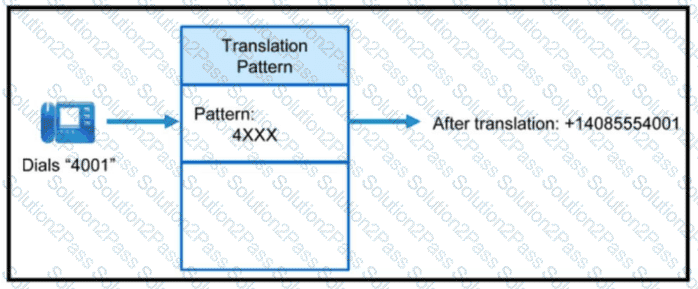
A company needs to ensure that all calls are normalized to ♦ E164 format. Which configuration will ensure that the resulting digit string ♦14085554001 is created and will be routed to the E.164 routing schema?
The SIP session refresh timer allows the RTP session to stay active during an active call. The Cisco UCM sends either SIP-INVITE or SIP-UPDATE messages in a regular interval of time throughout the active duration of the call. During a troubleshooting session, the engineer finds that the Cisco UCM is sending SIP-UPDATE as the SIP session refresher, and the engineer would like to use SIP-INVITE as the session refresher. What configuration should be made in the Cisco UCM to achieve this?
Which two statements are correct with respect to the Client Matter Code setting in the route pattern configuration? (Choose two.)
CollabCorp is a global company with two clusters, emea.collab corp and apac.collab.corp. URI dialing is implemented and working in each cluster. The company configured routing between clusters to make inter-cluster calls via URI. but this is not working as expected. Which two configuration elements should be checked to resolve this issue? (Choose two.)
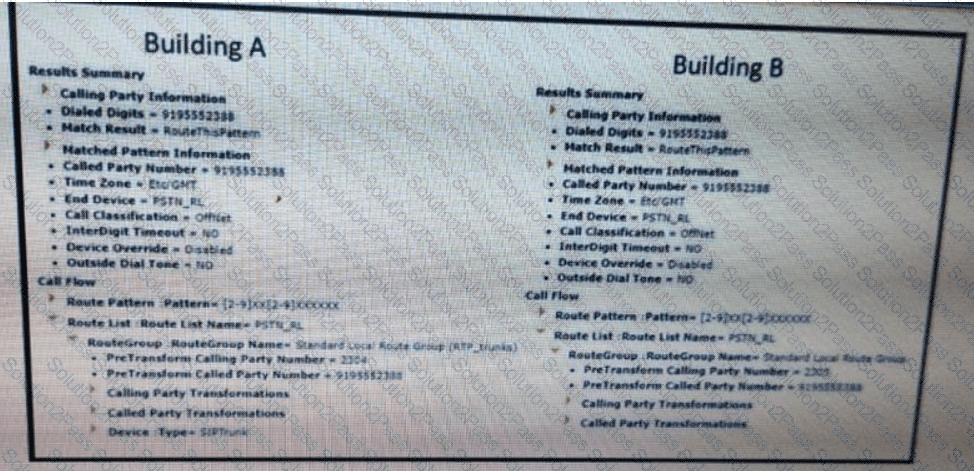
Refer to the exhibit. A standard local route group is configured for long-distance calls. Calls from building A succeed, but calls from building B fail. On the system. Each building has is own device pool. The DNA tool is used to test the configuration. How is this issue resolved?
Which top-level IOS command is needed to begin the configuration of a Cisco Unified Communications Manager Express gateway to enable phones to be registered via SIP?
An engineer must route all SIP calls in the form of
Drag and drop the steps from the left into the order to provision mobility users through LDAP on the right. Not all options are used.
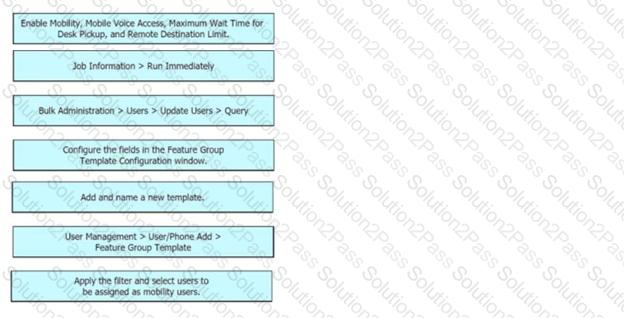
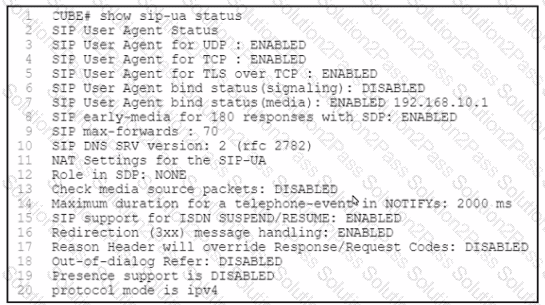
Refer to the exhibit An engineer deploys a Cisco Unified Border Element for SIP trunk interconnection to an ITSP The engineer performs test calls but there is no audio when the called party picks up the phone. What must the engineer do to resolve the issue?

Refer to the exhibit. An engineer is troubleshooting an issue where inbound Calls are failing after they transferred. The provider reports that update is not supported, and this is causing the calls to fail. Which command should resolve this issue?
ABC company has decided to implement hunt groups to help distribute calls between members. In order to implement this, administrator must configure hunt list, hunt group, and line groups on Cisco UCM. Which distribution algorithms should the administrator implement?
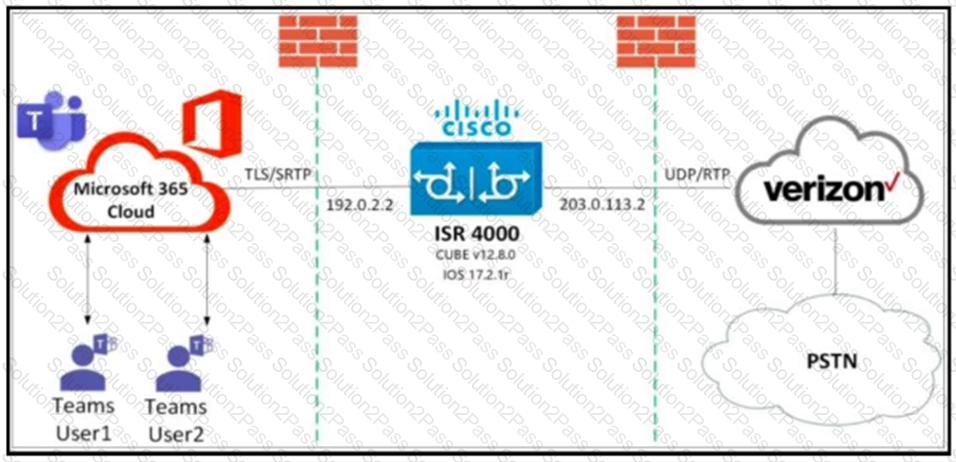
Refer to the exhibit. A company is using Microsoft Teams with Cisco Unified Border Element integration, but the administrator sees a one-way audio issue with Microsoft Teams. The administrator must modify the SIP profile to send the proper information on the SDP for IP address for media to match the internal and external interface. Which set of commands resolves the issue?
An SRST site must use pickup functionality on the Chicago remote site to allow the users to take incoming calls. The pickup command is configured under the call-manager-fallback section on the SRST router What are two results of that configuration? (Choose two.)

Refer to the exhibit. A Collaboration engineer is implementing call routing and must configure the Cisco Unified Border Element to register to multiple registrars using a SIP trunk listen port.
Which code snippet completes the configuration?
A company is using a H.323 gateway for PSTN calls from Cisco phones connected to a Cisco UCM cluster. There are reports of problems getting audio on these incoming calls from the PSTN. The phone rings, but nothing is heard and the call disconnects.
Which command troubleshoots this issue?
Refer to the exhibit.
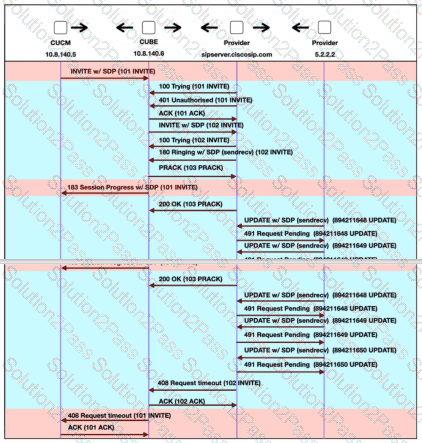
A Cisco Unified Border Element continues to send 180/183 with the required: 100rel header to Cisco UCM. and the call eventually disconnects How is the issue resolved?

